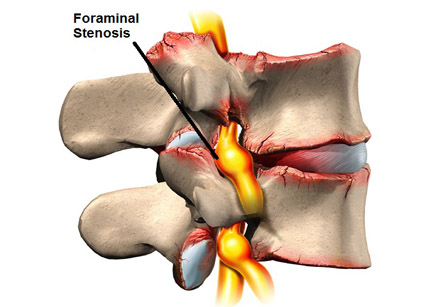Foraminal Stenosis
Introduction
Foraminal stenosis is a condition which involves narrowing of the spinal foramen, the hole through which a spinal nerve passes as it exits the spine (foramen basically means “hole”). This is usually a type of degenerative spine disease which occurs gradually over time with wear and tear of the spinal column. Pathological conditions such as arthritic changes of the spine, herniation of discs and bulging discs, soft tissue swelling and bony spurs can all impinge on the foramen and compress the nerve within.
A foramen exists at each level of the spine with one being on each side. At each level, a spinal nerve coming from or to the spinal cord passes through the foramen. As the foramen is a relatively small space, anything impinging on that area can cause foraminal stenosis and can pinch the nerves inside the foramen.
Although, foraminal stenosis generally occurs as a result of other degenerative disease of the spine, it can present as a primary problem in some patients. The symptoms can be caused at only one level or at many at the same time if more than one foramen (foramina) is involved.
We have all the information you need about public and private clinics and hospitals that provide spinal surgery in Iran, Islamic Republic Of with the best quality and lowest possible prices

Symptoms of foramen stenosis:
As the narrowing of the foramen pinches a nerve, the primary symptoms of this disorder are related to the nerve which is affected. This can obviously vary depending on which foramina are involved.
Any one foramen contains one nerve which goes to specific parts of the body and provides sensations as well as muscle movements to that part. A left-sided foramen contains a nerve which only goes to the left side of the body. Therefore, the symptoms associated with foraminal stenosis are always present on the side of the stenosis. It can affect both sensory and motor function in the area that the nerve supplies.
Generally, foramen disease in the lower part of the spine (called as the lumbar region) will lead to symptoms in the leg. Similarly, disease in the neck, called the cervical region, will lead to symptoms in the arm.
Other options are spinal injections which help to decrease the inflammation and swelling in the area.
The pinched nerve can lead to basically two classes of symptoms. First of all, sensory symptoms can occur, which include pain in the distribution of the nerve, numbness, tingling and other sensory abnormalities.
Also, motor symptoms can occur. These include weakness, abnormal tendon reflexes and even paralysis in severe cases. However, unlike the paralysis occurring from damage to the spinal cord itself, this paralysis is one sided (unless the foramina of both sides are affected severely). The paralysis is usually limited to the muscles which are normally controlled by that specific nerve.
Diagnosis:
First, complete history of the patient is explored and a thorough neurological examination is performed. An MRI scan of the spine is generally the preferred imaging study for evaluation of the foramen and other related areas of the spine. Plain x-rays and CT scan can also show good detail of the bony structures of the spine, but they are not as sensitive as MRI for the soft tissues and smaller structures such as the foramen and the nerve within. A good MRI can demonstrate foraminal stenosis as well as can evaluate other pathologies of the spine.
Treatment:
Treatment for degenerative spine disease varies considerably from patient to patient. In cases of foraminal stenosis, the treatment varies as well. Most patients are recommended first to undergo a period of conservative therapy which includes rest, physical therapy and anti-inflammatory medications. In some cases, this is usually enough for relieving the pressure on the nerve and also for improvement of symptoms.
Other options are spinal injections which help to decrease the inflammation and swelling in the area. Finally, if conservative treatments fail or if the symptoms are severe enough, some patients may even be offered surgical treatment. Surgery often involves other procedures to address the degenerative disease of the spine at the same time. However, the procedure generally used to specifically treat foraminal stenosis is called as Foraminotomy. This procedure is performed to open up the foramen so that the nerve within gets more room and is not compressed. The specifications of therapy for each patient can vary. Therefore, treatment decisions should not be generalized. Each patient should discuss their own case of spinal disease with their own physician and an appropriate treatment plan should mutually be decided.